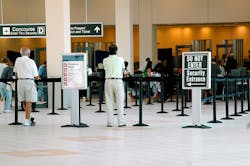New airport detection system is aviation security’s next innovative step
SCHAUMBERG, Ill. - On the morning of September 11, 2001, when Mohamed Atta and 18 other al-Qaida-affiliated terrorists checked into their various flights emanating from Boston's Logan International Airport, Liberty International Airport in Newark, N.J., and Dulles International Airport in Washington, D.C., airport security protocols for screening and boarding passengers were dangerously quick and easy. The worst that could happen is that a passenger, like Atta, would be selected for closer scrutiny and subjected to a security procedure called CAPPS (Computer Assisted Passenger Prescreening System), where the only consequence was holding a ticketed passenger’s checked bags until boarding was confirmed, Steve Lasky reports for Security Infowatch. Continue reading original article.
The Military & Aerospace Electronics take:
20 July 2022 - The Chertoff Group, partnering with IDSS to develop a solution based on Open Architecture DICOS imaging standards utilizing patented technology, which will allow access and interoperability with any checkpoint or checked baggage computed tomography (CT) system located anywhere in the world.
CT X-ray technology is derived from the medical space and used to find threats to aviation. CT systems take a series of X-ray images of a traveler’s bag, and electronically “stitches” them together into a high-resolution, three-dimensional rendering. A key component of the patent is its covert node, which allows bomb technicians at a secure non-airport location to create bags with real threat items and remotely assess the performance of all officers operating in the massive multiplexing environment concurrently.
Government entities armed with these insights can now target individuals for focused instruction and practice, and train artificial intelligence (AI) and machine learning (ML) algorithms. These system-wide performance insights can also inform enhancements to standard operating procedures and detection algorithms.
Related: 2022 Airport Business Project of the Year: PQS puts boarding info in passengers' hands
Related: Atlanta's Hartsfield-Jackson International Airport to get checkpoint tech upgrade
Jamie Whitney, Associate Editor
Intelligent Aerospace
